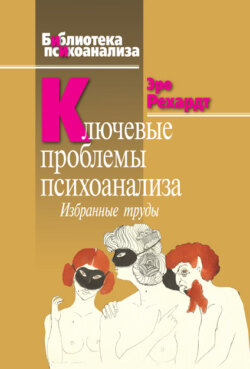Читать книгу Ключевые проблемы психоанализа. Избранные труды - Эро Рехардт - Страница 19
Как интерпретировать влечение к смерти?
Литература
ОглавлениеCohen J. & Kinston W. (1984). Repression theory: a new look at the cornerstone. Int. J. Psycho-Anal., 65: 411–422.
Eissler K. (1972). Death drive, ambivalence and narcissism. Psychoanal. Study Child, 26: 25–78.
Fisher C., Kahn E., Davis D. M. (1973). A psychophysiological study of nightmares and night terrors. J. Nerv. and Mental Disease., 157: 75–98.
Freud S. (1914). On narcissism: an introduction. S. E. 14.
Freud S. (1920). Beyond the pleasure principle. S. E. 18.
Freud S. (1923). The Ego and the Id. S. E. 19.
Freud S. (1925). Negation. S. E. 19.
Friedman J. A. (1992a). Freud’s Todestrieb: an introduction. Part 1. Int. Rev. Psycho-Anal., 19: 189–196.
Friedman J. A. (1992b). Freud’s Todestrieb. Part II. Int. Rev. Psycho-Anal., 19: 309–322.
Gill M. (1963). Topography and systems in psychoanalytical theory. Psychological Issues, vol. Ill, no. 2, New York: Int. Univ. Press.
Grunberger B. (1971). Narcissism. New York: Int. Univ. Press, 1971.
Hartmann H., Kris E. & Loewenstein R. M. (1949). Notes on the theory of aggression. Psychoanal. Study Child., 3–4: 9–36.
Ikonen P. & Rechardt E. (1978). The vicissitudes of Thanatos. On the place of aggression and destructiveness in the psychoanalytic interpretation. Scand. Psychoanal. Rev., 1: 94–114.
Ikonen P. & Rechardt E. (1980a). Binding, narcissistic psychopathology and the psychoanalytic process. Scand. Psychoanal. Rev., 3: 4–28.
Ikonen P. & Rechardt E. (1980b). Aggression, destruction et pulsion de mort dans les ecrits Freud. Les pulsions, ed.: J. Chassegue-Smirgel, pp. 157–166. Paris: Tchou.
Ikonen P. & Rechardt E. (1980c). Les vicissitudes de Thanatos. Les pulsions, ed.: J. Chassegue-Smirgel, pp. 167–186. Paris: Tchou.
Ikonen P. & Rechardt E. (1993). The origin of shame and its vicissitudes. Scand. Psychoanal. Rev., 16: 100–124.
Jacobson E. (1954). The self and the object world. Vicissitudes of their infantile cathexes and their influence on ideational and affective development. Psychoanal. Study Child., 9: 75–127.
Klein M. (1948). A contribution to the theory of anxiety and guilt. Int. J. Psycho-Anal., 29: 114–123.
Laplanche J. (1976). Life and Death in Psychoanalysis. Baltimore: John Hopkins Univ. Press.
Laplanche J. (1981). A metapsychology put to the test of anxiety. Int. J. Psycho-Anal., 62: 81–89.
Lewin K. (1987). Aristotelisesta Galilealaiseen ajattelutapaan biologiassa ja psykologiassa. Psykologia, liite. 3: 2–14 (From Aristotelian to Galilean thinking in biology and psychology. Published in J. Gener. Psychol., 5: 141–177, 1931).
Lind L. (1991). Thanatos: the drive without a name. The development of the concept of the death drive in Freud’s writings. Scand. Psychoanal. Rev., 14: 60–80.
Rechardt E. & Ikonen P. (1986a). Apropos de I’interpretation de la pulsion de mort. La pulsion de mort. pp. 61–74, Paris: Presses Universitaires de France.
Rechardt E. & Ikonen P. (1986b). Die Interpretation des Todestriebs. Psychoanalyse Heute, pp. 45–61. Wien: Orac.
Rechardt E. (1986). Les destins de la pulsion de mort. La pulsion de mort. pp. 39–48. Paris: Presses Universitaires de France.
Schur M. (1955). Comments on the metapsychology of somatization. Psychoanal. Study Child., 10: 119–164.
Segal H. (1993). On the usefulness of the concept of death instinct. Int. J. Psycho-Anal., 74: 55–61.
